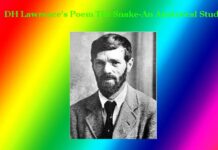Shakespeare | Sonnet 2 | Text with Critical Study
Shakespeare | Sonnet 2 | A Critical Study
(Shakespeare’s Sonnet 2: Text, Analytical Study | Word-Notes | Faqs)
Shakespeare’s Sonnet 2 – Text
When forty winters shall beseige thy brow,
And dig deep trenches in thy beauty’s field,
Thy youth’s proud livery, so gazed on now,
Will be a tatter’d weed, of small worth held:
Then being ask’d where all thy beauty lies,
Where all the treasure of thy lusty days,
To say, within thine own deep-sunken eyes,
Were an all-eating shame and thriftless praise.
How much more praise deserved thy beauty’s use,
If thou couldst answer ‘This fair child of mine
Shall sum my count and make my old excuse,’
Proving his beauty by succession thine!
This were to be new made when thou art old,
And see thy blood warm when thou feel’st it cold.
Shakespeare’s Sonnet 2 – An Analytical Study
Thematic Analysis:
The central theme of Shakespeare’s Sonnet 2 is the power of procreation and its ability to preserve beauty and youth beyond the limitations of time. The speaker urges the young man to consider the inevitability of aging and the eventual decay of his physical beauty and suggests that the only way to truly transcend this fate is through the creation of offspring.
The sonnet begins with a vivid description of the effects of time on the young man’s appearance, using the metaphor of “forty winters” besieging his brow and “digging deep trenches” in his “beauty’s field.” The speaker laments the fleeting nature of youth and beauty, noting that the “proud livery” of the young man’s youth will eventually become a “tattered weed” of little worth.
The second quatrain presents a hypothetical scenario in which the aged man is asked where all his beauty and vitality have gone. The speaker argues that it would be a shameful and futile response to claim that these qualities are still present within his own “deep-sunken eyes.” Instead, he suggests that the man’s greatest legacy would be to produce a child who would inherit his beauty and continue his lineage.
In the final tercet, the speaker asserts that such an act of procreation would enable the young man to “be new made” even in old age, experiencing a sense of vitality and warmth through the connection to his offspring. This idea is encapsulated in the final couplet, which emphasizes the transformative power of procreation: “And see thy blood warm when thou feel’st it cold.”
Literary Device Analysis:
The sonnet employs a range of literary devices to convey its themes and ideas. One of the most prominent is the use of extended metaphors, particularly in the opening quatrain, where the effects of aging are compared to a siege and the destruction of a field. This metaphor is continued throughout the poem, with the image of a tattered weed symbolizing the decay of youth and beauty.
The poem also makes use of rhetorical devices such as rhetorical questions, repetition, and parallel structure. The second quatrain, for example, features a series of questions that emphasize the futility of trying to retain one’s beauty in old age. The repetition of “where” and “all” in these lines emphasizes the scope of this loss.
The sonnet also features a turn or volta in its final two lines, where the focus shifts from the inevitability of aging to the transformative power of procreation. This turn is emphasized by the use of the conditional “If” at the beginning of the third quatrain, which sets up the hypothetical scenario of a child inheriting the young man’s beauty.
Finally, the sonnet’s use of iambic pentameter and its strict rhyme scheme (ABAB CDCD EFEF GG) give it a musical quality that underscores the speaker’s message. The use of end rhymes, in particular, creates a sense of closure and resolution in the final couplet. 0 0 0.
Shakespeare’s Sonnet 2-Word Notes
Sonnet 2 by William Shakespeare is one of his famous 154 sonnets. Here are some word notes to help understand the poem better:
When forty winters shall besiege thy brow:
The speaker is addressing a young man, warning him that when he grows older, his looks will fade.
And dig deep trenches in thy beauty’s field:
The metaphorical language compares wrinkles to trenches, suggesting that they will ruin the beauty of the young man’s face.
Thy youth’s proud livery so gazed on now:
The youth’s physical appearance is admired by many, but this will not last forever.
Will be a tottered weed of small worth held:
The youth’s beauty will become worthless and insignificant as he grows old.
Then being asked where all thy beauty lies:
When the young man grows old, people will ask him where his beauty has gone.
Where all the treasure of thy lusty days:
People will also ask the young man what happened to his youthful energy and vitality.
To say within thine own deep-sunken eyes
The young man will have to answer these questions himself, looking into his own eyes to find the truth.
Were an all-eating shame and thriftless praise:
The speaker suggests that it would be shameful and useless to rely on past beauty and accomplishments, as they will not last.
Overall, Sonnet 2 warns against the fleeting nature of physical beauty and urges the young man to focus on developing inner qualities that will endure over time.
Shakespeare’s Sonnet 2-Faqs
Q: What is Shakespeare’s Sonnet 2 about?
A: Shakespeare’s Sonnet 2 is about the transience of youth and beauty, and the importance of procreation as a way of preserving one’s beauty beyond one’s own lifetime.
Q: What is the tone of Shakespeare’s Sonnet 2?
A: The tone of Shakespeare’s Sonnet 2 is both admonitory and celebratory. It admonishes the young man to use his beauty while he still has it and to procreate in order to ensure that his beauty lives on after him. At the same time, it celebrates the power of procreation as a way of transcending death and preserving one’s beauty.
Q: What is the rhyme scheme of Shakespeare’s Sonnet 2?
A: The rhyme scheme of Shakespeare’s Sonnet 2 is ABAB CDCD EFEF GG.
Q: What literary devices are used in Shakespeare’s Sonnet 2?
A: Shakespeare’s Sonnet 2 uses several literary devices, including metaphor, personification, alliteration, and rhetorical questions.
Q: What is the meaning of the phrase “all-eating shame” in Shakespeare’s Sonnet 2?
A: The phrase “all-eating shame” in Shakespeare’s Sonnet 2 means that to claim that one’s beauty resides only within oneself is a shameful and wasteful attitude since it does not allow that beauty to be passed on to future generations through procreation.
Q: What is the significance of the phrase “tattered weed” in Shakespeare’s Sonnet 2?
A: The phrase “tattered weed” in Shakespeare’s Sonnet 2 suggests that youth and beauty are fleeting and impermanent and that they will eventually decay and lose their value if not preserved through procreation.
Q: What is the significance of the phrase “thy beauty’s field” in Shakespeare’s Sonnet 2?
A: The phrase “thy beauty’s field” in Shakespeare’s Sonnet 2 is a metaphor for the young man’s face, which is like a field that will be besieged by time and eventually become ravaged by wrinkles and age. The phrase emphasizes the vulnerability of youth and beauty to the ravages of time.
Q: What is the significance of the phrase “make my old excuse” in Shakespeare’s Sonnet 2?
A: The phrase “make my old excuse” in Shakespeare’s Sonnet 2 suggests that the young man’s child will be an excuse for his own aging and decay since the child will be a reflection of the young man’s beauty and thus a way of preserving it beyond his own lifetime. ***
N.B. This article originally belongs to the book entitled ‘Shakespeare’s Sonnets-Critical Studies‘ by Menonim Menonimus.
Books of Literary Criticism by M. Menonimus:
- World Short Story Criticism
- World Poetry Criticism
- World Drama Criticism
- World Novel Criticism
- World Essay Criticism
- Indian English Poetry Criticism
- Indian English Poets and Poetry Chief Features
- Emily Dickinson’s Poetry-A Thematic Study
- Walt Whitman’s Poetry-A Thematic Study
- Critical Essays on English Poetry
- Tawfiq al-Hakim’s Novel: Return of the Spirit-An Analytical Study
- Tawfiq al-Hakim’s Novel: ‘Yawmiyyat Naib Fil Arayaf’-An Analytical Study
- Analytical Studies of Some Arabic Short Stories
- A Brief History of Arabic Literature: Pre-Islamic Period (500 AD-622 AD)
- A Brief History of Arabic Literature: Early Islamic Period (622 AD-661 AD)
- Reviews on William Shakespeare’s Works
- Reviews of Charles Dickens’ Works
- Reviews of John Milton’s Literary Works
- Reviews of Some Iconic Travelogues
- Shakespeare’s Sonnets-Critical Studies …
Additional Searches:











